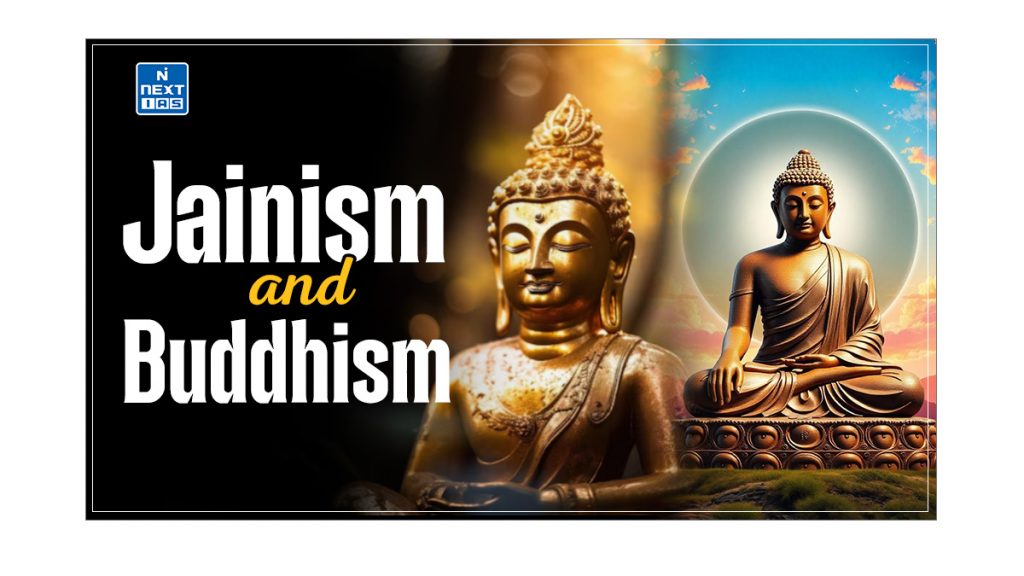
Jainism and Buddhism are ancient Indian religions that emerged in the 6th century BCE. They offer distinct paths to spiritual liberation. Their teachings have profoundly influenced Indian culture and continue to resonate globally, emphasising nonviolence and ethical living. This article aims to study in detail the origins, philosophies, similarities, and differences of Jainism and Buddhism, and other related aspects.
About Jainism and Buddhism
- Jainism and Buddhism are two of the most ancient and influential religions that originated in India.
- Jainism and Buddhism emerged as significant spiritual movements during the 6th century BCE, offering alternative paths to spiritual liberation distinct from the dominant Vedic traditions.
- Buddhism, founded by Gautama Buddha, emphasises the Four Noble Truths and the Eightfold Path as a means to achieve enlightenment and liberation from the cycle of birth and rebirth.
- Jainism, established by Lord Mahavira, advocates for a life of strict non-violence, asceticism, and adherence to the Five Vows as the path to liberation.
- Despite their differences, both Jainism and Buddhism share common themes of non-violence, karma, and renunciation.
Rise of New Religion (Jainism and Buddhism)
- The 6th Century B.C. was a period of religious revolution in various parts of the world.
- It was an age when great religious teachers, philosophers and thinkers lived. They tried to understand the mysteries of existence and the relationship between human beings and the cosmic order.
- Their ideas made revolutionary changes in all aspects of life.
- For example, Zoroaster (also known as Zarathustra) preached new doctrines in Persia and Confucius in China.
- In India, too, the 6th century B.C. saw many changes. For example, in India, Jainism and Buddhism were among the most essential religions and emerged as the most potent religious reform movements.
- Janism and Buddhism developed around mid-Gangetic plains, i.e. Magadha (Bihar region) and continue to thrive in modern times.
Reasons for the Rise of New Religions
The primary reasons for the rise of new religions (Jainism and Buddhism) are:
- Four-Fold Stratification of Society – In post-Vedic times, society was divided into four Varnas: Brahmanas (teachers and priests), Kshatriyas (rulers and administrators), Vaishya (merchants and bankers) and Shudra (artisans and labourers).
- The higher a person’s Varna, the more privileged and pure they were considered. Conversely, the lower a person’s Varna, the harsher the punishment prescribed for any offenses they committed.
- Additionally, the Kshatriya opposition to the dominance of the Brahmanas, the priestly class that claimed various privileges, contributed to the emergence of new religions.
- Both Vardhamana Mahavira, the founder of Jainism, and Gautama Buddha, the founder of Buddhism, belonged to the Kshatriya clan and challenged the authority of the Brahmanas.
- Rise of New Agricultural Economy – The real reason was the rise of a new agricultural economy in North-Eastern India.
- The agriculture economy based on the iron plough share required bullocks and could not flourish without animal husbandry.
- However, the Vedic practice of killing cattle in sacrifices decimated cattle wealth.
- The tribal people living in Southern and Eastern Magadha also killed cattle for food. Jainism and Buddhism propagated the ideal of ahimsa and spoke out against the Vedic sacrifices.
- Growth of Cities and Trade/Commerce in North-Eastern India – This period saw the rise of many cities in northern India, such as Kaushambi near Allahabad, Kusinagar, Benaras, and Vaishali.
- These cities also had many artisans and traders who began using coins for the first time (punch-marked coins).
- The use of coins naturally facilitated trade and commerce, adding to the Vaishyas’ importance.
- As Vaishyas ranked third in Brahmanical society, they naturally sought a religion to improve their position.
- Buddha and Mahavira’s path of non-violence would end wars and promote trade.
- Unfollowing Dharmashashtras would allow Vaishyas to lend money on interest, which would not have been possible otherwise.
- Material Life to Simple Life – The emergence of new forms of property led to social inequalities, resulting in widespread misery and suffering.
- In response, people sought a return to the ascetic ideal, rejecting these new forms of property and the lifestyle changes they brought.
- Jainism and Buddhism both advocated for a simple, ascetic way of life.
- This movement was a reaction to the material changes in the mid-Ganga plain during the 6th and 5th centuries B.C., much like how the Industrial Revolution prompted many to desire a return to a simpler, pre-machine age existence.
- Similarly, people of that time longed to revert to life before the advent of the iron age.
- Language – Buddhism used Pali, and Jainism used Prakrit. Both were languages of the common people, which helped in their spread.
- Curiosity, Debates, and Discussions – In the 6th century BC, people became curious about the meaning of life, death, and rebirth. Numerous questions led to questions about existing realities.
- There would be lively discussions and debates held in Kutagara-shala (hut with a pointed roof), where philosophers would win over their rivals and gain many followers.
- Many teachers, including Mahavira and Buddha, questioned the authority of the Vedas.
- They said anyone could attain liberation without differentiating between men and women, class and creed, and economic status.
Buddhism in India
- Buddhist literature is vast and diverse, with the Tripitaka, or Pali Canon, being the most authoritative and earliest collection of scriptures.
- Divided into three “baskets”—the Sutta Pitaka (teachings of the Buddha), the Vinaya Pitaka (monastic rules), and the Abhidhamma Pitaka (philosophical analysis)—it forms the foundation of Theravada Buddhism.
- Mahayana Buddhism later developed its own extensive body of literature, including the Mahayana Sutras like the Lotus Sutra and the Heart Sutra, which emphasise the Bodhisattva path and the idea of universal salvation.
- Another significant part of Buddhist literature is the Jataka Tales, which recount Gautama Buddha’s previous lives and teach moral lessons and virtues.
- The Buddhacarita, an epic poem by Ashvaghosha, narrates the Buddha’s life and is a key example of classical Sanskrit literature.
- Over time, Buddhist scholars like Nagarjuna and Vasubandhu wrote influential commentaries and philosophical texts, further expanding on the Buddha’s teachings.
- This rich literary tradition played a crucial role in spreading Buddhism across Asia, with translations into languages like Chinese, Tibetan, and Japanese, facilitating the growth of diverse Buddhist traditions.
Read our detailed article on Buddhism and Buddhist Literature.
Jainism in India
- Jainism has a rich literary tradition that reflects its deep philosophical and ethical teachings.
- The primary scriptures of Jainism are known as the Agamas, which are divided into two main categories: the Svetambara Agamas and the Digambara texts.
- The Svetambara sect considers the Agamas its canonical scriptures, which include the Angas, Upangas, and other texts covering Jain doctrine, ethics, and monastic rules.
- On the other hand, the Digambara sect relies on a different set of texts, such as the Samayasara and Tattvartha Sutra, the latter of which is universally accepted across both sects.
- Jain literature also includes extensive commentaries, philosophical treatises, and poetry.
- Renowned Jain scholars like Umasvati, who authored the Tattvartha Sutra, and Kundakunda, known for works like the Pravachanasara, made significant contributions to Jain philosophy, particularly in the areas of metaphysics and ethics.
- The literature also includes the Kalpa Sutra, which recounts the lives of the Tirthankaras, particularly Lord Mahavira, and is recited during important Jain festivals like Paryushana.
Read our detailed article on Jainism.
Similarities between Jainism and Buddhism
The similarities between Jainism and Buddhism religions have been discussed in detail in the table below.
| Reason | Jainism and Buddhism |
| Origin | Jainism and Buddhism were founded by Kshatriyas in Eastern India. |
| Vedas | Jainism and Buddhism were against the ritualistic interpretation of Vedas and opposed Brahmanical domination. They uphold the essence of the Vedas. |
| Teachings | Jainism and Buddhism preached truth, non-violence, celibacy and detachment from material comforts. |
| Religion type | Jainism and Buddhism were non-theistic religions. |
| Beliefs | Jainism and Buddhism believed in Karma and rebirth. |
| Importance to lower caste and women | Jainism and Buddhism allowed Kshudras and women to follow the religion, become monks and attain salvation. |
| Language | Jainism and Buddhism spread as a result of teaching in the language of the common men. |
| Caste belief | Jainism and Buddhism were opposed to the caste system but could not eliminate it. |
Differences between Jainism and Buddhism
The differences between Jainism and Buddhism religions have been discussed in detail in the table below.
| Reason | Jainism and Buddhism |
| Followers | Jainism gave prominence to lay followers, while Buddhism relied mainly on the Sangha and its monks. |
| Method of salvation | The method of attaining salvation for Jainas was extreme, but for Buddhists, it was moderate. |
| Spread | Jainism was confined to India but survived there. Buddhism spread rapidly to foreign lands but died in India. |
| Status of women | Jainism is more liberal in its treatment of women. |
| Belief | Jainism believed in the soul, and Buddhism did not. |
| Ahimsa | Jainism laid an over-emphasis on Ahimsa. In Buddhism, Ahimsa meant liberal feelings and practical behaviour. |
Conclusion
Jainism and Buddhism, emerging in 6th-century BCE India, significantly influenced the region’s spiritual and cultural development. Jainism and Buddhism offered unique paths to spiritual liberation, emphasising non-violence, ethical living, and renunciation. While Buddhism spread widely across Asia, Jainism remained deeply rooted in India. The rich literary traditions of Jainism and Buddhism continue to impact religious thought globally. Understanding these religions offers key insights into Indian history and enduring principles of compassion and simplicity.
Frequently Asked Questions (FAQs)
What is the difference between Jainism and Buddhism?
Jainism and Buddhism differ primarily in their views on asceticism and the soul. Jainism emphasizes extreme asceticism and the belief in an eternal soul (jiva). At the same time, Buddhism advocates a Middle Path, rejecting extreme asceticism and not focusing on the concept of an eternal soul, emphasising instead the doctrine of anatta (no-self).
Who is the father of Jainism and Buddhism?
The “father” or founder of Jainism is traditionally considered Lord Mahavira, the 24th Tirthankara. The “father” or founder of Buddhism is Siddhartha Gautama, also known as Gautama Buddha.
What are the 5 doctrines of Jainism?
The five main doctrines of Jainism, also known as the Five Vows (Mahavratas), are:
– Ahimsa (Non-violence)
– Satya (Truthfulness)
– Asteya (Non-stealing)
– Brahmacharya (Celibacy or Chastity)
– Aparigraha (Non-possession or Non-attachment)






